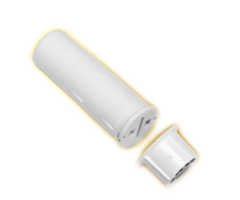ISC West 2019 - New 2GIG Offerings
Posted By Michael GorisMore ISC West excitement DIYers! Our team just checked out the Nortek and 2GIG booth at ISC West 2019. We can certainly say there were many intriguing new 2GIG products to look at. Nortek went all out this year, as the company has some great new systems and sensors coming in the pipeline!
The key word for 2GIG this year is "Encryption". The company is planning to release their new GC2e System this May and their new GC3e System this July. These systems are modeled after the existing GC2 and GC3 Systems respectively. The exact release dates are still up in the air, but 2GIG is confident that they will both hit the market by the aforementioned months.
The "e" in these names stands for encryption. 2GIG will finally offer systems that support encrypted sensors. The GC2e and GC3e will both support the company's brand-new lineup of encrypted "eSeries" devices that will stop hackers dead in their tracks. Although 2GIG is somewhat late to the party in adding encrypted sensors, this is still a huge addition to their lineup.
The new eSeries Sensors are designed exclusively for use with the GC2e and GC3e Systems, and they will not be backwards compatible with the current GC2 and GC3 models. However, you will be able to use current non-encrypted 2GIG 345 MHz Sensors and the legacy Honeywell 5800 Series Sensors with the GC2e and GC3e Systems.
The GC2e System is the standard, more-affordable option of the two new panels. Modeled after the current Go!Control GC2, the new GC2e Panel offers a larger 5-inch touchscreen display and a slightly re-tooled designed. We tested this panel, and we were particularly impressed with the overall design and satisfying touch controls. It also offers Z-Wave Plus technology.
Meanwhile, the GC3e System offers everything available for the GC2e, plus a little bit extra. The panel adds WIFI connectivity, which is unavailable for the GC2e. The Smart Areas feature from the original GC3 is also being carried over to the GC3e, as the system will be capable of supporting up to four "Smart Area" partitions. Finally, GC3e users will appreciate the panel's 7-inch touchscreen display and its touched up design. Just like the GC2e, the GC3e also supports Z-Wave Plus devices.
It should be noted that there were no new keypads announced for either system. However, the systems will be able to support the existing models for their older counterparts. In other words, the GC2e will support the 2GIG TS1 Keypad, while the GC3e will support the 2GIG SP1 Keypad. Both will support the 2GIG PAD1-345 Touch Button Keypad.
We would also like to briefly touch upon new sensors, some of which are already available on our site. Just last week, the 2GIG STVGRL1-345 Stove and Grill Guard, the 2GIG GNGRD1-345 Gun Trigger Lock, the 2GIG DW30 Outdoor Sensor and the 2GIG F1-345 Personal Safety Pendant were all made available for purchase on the Alarm Grid site.
And it wouldn't be ISC West without some new sensors! We were particularly excited by the new 2GIG Water Leak Detector and the 2GIG Bypass Door and Window Sensor. The water leak detector has a useful design that should help it detect leaks more accurately than standard flood sensors. Meanwhile, the 2GIG Bypass Door and Window Sensor can be conveniently bypassed by pressing a button right on its front!
We plan on taking a closer look at the new 2GIG offerings later during ISC West 2019. Until then, stay tuned for more information from ISC West 2019 and Alarm Grid!






























